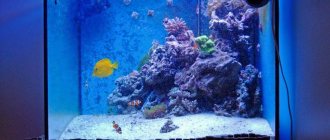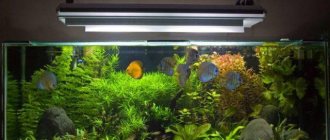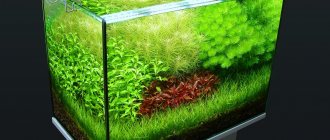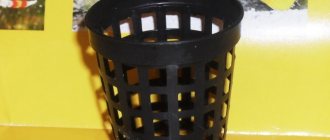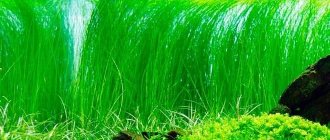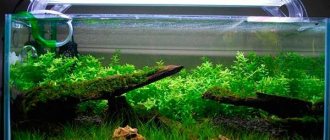General characteristics of aquarium lighting
The main characteristics of lighting include power, color temperature, color rendering coefficient and light spectrum.
Power is the energy that is transferred by radiation through a surface per unit time. The power of lighting sources for aquariums is 8-56 W.
Color temperature of aquarium lamps.
Color temperature is a parameter that measures a person’s perception of the color of light flux. Based on the value of this value, lighting is considered warm, cold or neutral. Blue means high color temperature, red means low.
The color temperature of shades of white light is as follows: warm white - 3000 K, cool white - 5000 K, neutral white - 4000 K. Lighting devices with a color temperature of 6500-8000 K can convey the natural color of underwater plants.
Color rendering coefficient – this parameter determines the degree of correspondence between colors visible to humans and natural colors. The values of this coefficient range from 0 to 100.
If it is 0, then the lighting fixture does not transmit colors. If the coefficient is in the range from 91-100, then the color is as close as possible to the original.
The light spectrum is a range of waves visible to the human eye from 380 to 789 nm, which are perceived as different colors. Short waves in our perception are violet, long waves are red.
Selection by volume
Lighting levels are calculated using the watts per liter rule. The total power of all light sources in the aquarium must be divided by its volume. A value of 0.1 W/l or more means that the lighting is strong, 0.25 W/l is weak.
An example of properly selected lighting for a large aquarium.
With the active use of energy-saving technologies, this rule has ceased to be universal. Different lighting devices, having the same power, emit different amounts of light.
Therefore, when selecting the level of illumination, lumens began to be used instead of watts. The total number of lumens must be divided by the volume of the tank. A high level of illumination is considered to be more than 50 Lm/l, low – 15-25 Lm/l, medium – 25-50 Lm/l.
Light intensity
Lighting levels are calculated using the watts per liter rule. The total power of all light sources in the aquarium must be divided by its volume. A value of 0.1 W/l or more means that the lighting is strong, 0.25 W/l is weak.
With the active use of energy-saving technologies, this rule has ceased to be universal. Different lighting devices, having the same power, emit different amounts of light. Therefore, when selecting the level of illumination, lumens began to be used instead of watts. The total number of lumens must be divided by the volume of the tank. A high level of illumination is considered to be more than 50 Lm/l, low – 15-25 Lm/l, medium – 25-50 Lm/l.
Common Mistakes
The main mistakes novice aquarists make are the following:
- incorrectly selected daylight hours, which causes vegetation to experience either a lack of light or an excess of it;
- poorly chosen lamps that emit red or blue colors without white, close to natural.
It is best to use white lighting for aquarium plants, which is as close to natural as possible. Red or blue lamps must be additionally illuminated with white lighting. But the backlight time should not be more than 12 hours.
It is best to use white lighting for aquarium plants.
Types of lamps
Halogen and incandescent lamps
Halogen and incandescent lamps are affordable and produce light similar to that of the sun. At the same time, they heat up and overheat the water in the aquarium. This type can be used in aquariums without harm to fish and vegetation only by first installing coolers that remove heat. A small part of the energy of a halogen lamp (3%) is spent on lighting, and this is its disadvantage. The service life is short and amounts to 1000 hours.
Lighting the aquarium using three lighting fixtures with metal halogen lamps.
Metal halogen
Metal halide lamps have intense radiation and imitate sunlight. They are designed for lighting marine aquariums. Used depending on the luminous flux power with compatible ballasts.
Devices of this type emit point light, so the heat is concentrated at one point. To avoid overheating of water, install coolers or periodically turn off lighting fixtures. The power of the metal halogen lamp is 70-1000 W.
LED
Light-emitting diode lamps (LED) have a rich color spectrum and maintain it throughout their entire service life. They do not heat up much, consume minimal electricity and last up to 50,000 hours. Various color combinations allow you to customize the intensity and color of the lighting in your aquarium. Compared to fluorescent sources, the light direction of such a lamp is point-like, does not scatter to the sides and does not require the installation of reflectors.
Luminescent
Fluorescent lamps are one of the most popular types of lamps for aquarium lighting.
For shallow tanks up to 50 cm deep, fluorescent lamps with normal luminous efficiency are used. For deep aquariums, the High Output and Very High Output models with high radiation efficiency are suitable. Their intense light penetrates to great depths.
The disadvantage of fluorescent lamps is that they do not retain the color spectrum for their entire service life and require replacement every six months to a year.
Aquarists use lamps with T5 and T8 sockets (12 and 26 mm). Compared to T8, T5 sources are more expensive, but they emit 2 times more light.
Combined lighting
A combination of several devices of different types will help create an optimal light balance in the aquarium. The most common combination is fluorescent lamps and LED; fluorescent and metal halogen lamps are less commonly used. They are also combined according to light temperature..
Light in the aquarium
To ensure that beginners in the aquarium business do not make unforgivable mistakes, remember that inside the aquarium there is a real biological environment in which life develops, and the laws of this development are in your hands, as the creator of this world. Lighting allows not only fish, but also plants to develop properly, but its amount should not be insufficient or, conversely, excessive. All this leads to unpleasant consequences.
Professional aquarists still argue about the power and spectrum of lighting, which indicates the rather high complexity of the issue. Therefore, in order for beginners to avoid the most common mistakes, we will try to analyze the most important information in this article. The rest you can only learn from your own experience.
Result of improper lighting
Let's start by naming the main problems that arise when the lighting conditions are incorrect.
Such an environment may be unfavorable for aquarium fish, and there is no beauty to be seen here
- Too bright and prolonged lighting causes abundant growth of algae, which leads to rapid contamination of the tank - the water begins to bloom.
- The light cycle of plants should be close to natural, that is, about 10-12 hours. However, some specifically increase the luminosity period to stimulate faster growth of aquarium flora. We do not recommend overdoing it, as too long, even, or short periods of lighting disrupt the natural biorhythms of plants, causing them stress. For this reason, plants often begin to get sick.
- Certain types of aquarium plants require long and bright light for normal growth. The catch here is that such a regime can harm the fauna, that is, the fish. As a result, many fish, accustomed to living in shaded areas in natural conditions, begin to fade, losing the brightness of their color. They hide from the bright light among algae and stones, instead of swimming and pleasing the eye of the observer.
This aquarium seems uninhabited
- Another problem is associated with aquariums whose height exceeds the standard 38 centimeters. The fact is that due to the height, very little light reaches the bottom of the aquarium, so ground plants begin to suffer. The mistake beginners make is that they increase the lighting levels to support their development.
- As a result, the fish become inactive and try to find a secluded corner where they can hide from the annoying light. Soon the water begins to bloom, and in such conditions, pathogenic bacteria very often begin to develop, which can greatly harm the fauna.
This concerns an overabundance of lighting. And what happens to plants when there is not enough light:
- The fact is that light (its power) is the main parameter on which the development of flora completely depends. If you try to compensate for the lack of lighting with fertilizers and carbon dioxide, then be prepared for a fiasco.
- The consumption of CO2 by plants directly depends on the intensity of total daylight, and no fertilizer can affect this.
- The reason is simple - the reaction of photosynthesis cannot occur without the energy that plants obtain from light. As a result of this reaction, they begin to convert CO2, minerals and water into organic tissue. Remember your school biology course - unlike us and animals, plants are autotrophic organisms!
- If light does not reach the plants, then carbon dioxide and all kinds of fertilizers remain unclaimed. The result of such a light regime can already be imagined without being a biologist. Plants will slow down in development or simply die.
- As soon as we increase the brightness, we immediately see rapid development, lush plants and vibrant greenery. The oxygen bubbles that cover the leaves will immediately become noticeable.
Bubbling of plants in an aquarium is a sign of photosynthesis occurring.
This process means saturating the water in the aquarium with oxygen, which is required by fish and other underwater inhabitants. If you observe a similar phenomenon in your aquarium, it means you did everything right. The rules of nature are unchanged - photosynthesis requires three elements: light, water and mineral inorganic substances, also known as fertilizers.
Common Mistakes
We have already said that increasing the length of daylight hours for an aquarium can have negative consequences, in the form of rampant development of algae and rapid clogging of the water in the aquarium.
- An attempt to use light sources with peaks of blue or red light as aquarium lamps leads to similar results. As a result, threads, beards and other troubles develop in the aquarium.
- It is quite difficult to control such pests, so it is better to prevent their appearance at all.
- You can come across a lot of advice on the Internet talking about the benefits of the blue and red spectrum, saying that in normal lighting they are not enough for normal plant growth. The answer, we think, suggests itself. Since they grow with the natural spectrum in nature, they should also grow with it in the aquarium.
- Contrary to these myths, plants do not consume only these spectra. In fact, absorption occurs more or less evenly across the entire visible light spectrum, that is, the use of lamps with extreme spectra is unfounded and can only harm flora, not to mention fauna.
Advice! If we talk about light temperature, then the optimal lamps for plants are 6500-8000 Kelvin, which we will discuss in more detail later.
However, the use of lamps of extreme spectra is possible, but only in combination with other colors, that is, the organization of mixed lighting.
General lighting rules
The rules for lighting aquariums are based on the standards of luminous flux per liter of water.
The standards are given for halogen lamps and incandescent lamps:
- 0.2-0.4 W/l – shade-loving plants and fish;
- 0.4-0.5 W/l – plants that do not require lighting;
- 0.5-0.8 W/l – standard herbalist;
- 0.8-1.0 W/l – light-loving plants.
On the left is lighting for light-loving plants, on the right is dim light for shade-loving plants.
Harm of phytolamps to people and animals
- When used correctly, phytolamps are absolutely safe for humans and animals. Fluorescent and mercury lamps may pose a minor hazard. If the flask is damaged, mercury evaporates into the air and can cause poisoning with prolonged exposure. Therefore, damaged lamps must be disposed of immediately.
- If the sodium flask is damaged, vapors of a mixture of mercury and sodium enter the air. With short-term contact they are harmless to humans and animals. With prolonged exposure, vapors can cause exacerbation of chronic diseases. Sodium lamps also need to be replaced immediately when chips or cracks appear.
- LED lamps do not contain vapors of harmful metals and trace elements. At the same time, the lamps emit ultraviolet light. Their use at night can disrupt the production of melatonin, the sleep hormone.
- Inexpensive phytolamps have one significant drawback. The light from such lamps constantly blinks and can cause fatigue and irritation of the mucous membranes of the eyes. With prolonged exposure, migraines, decreased visual acuity, and decreased performance may occur.
- Prolonged exposure to blue light can cause blurred vision and fatigue. At night, exposure to blue light causes insomnia.
- When exposed to red spectrum waves for a long time, a person may feel dizzy. Rapid heartbeat and nausea. Red waves can provoke an exacerbation of inflammatory processes and cause burns on the skin.
- Flashing light bulbs can have a negative impact on large pets. Avoid leaving cats and dogs exposed to blue and red light for long periods of time.
- Phytolamps are safe for birds. In livestock farms, infrared lamps are often used to prevent outbreaks of mass diseases.
- But for turtles and other amphibians, the light of fluorescent lamps, on the contrary, is useful. It gives them the necessary amount of heat and ultraviolet radiation. LED lighting is made for aquarium fish.
- To ensure that lighting does not cause problems, it is best to install phytolamps with a power of no more than 80 W at home.
- Reflux halogen lamps contain mirror reflectors and can be used indoors without harm to health.
Best Aquarium Lamp Brands
Phyto lamps
The Sylvania GRO-LUX lamp enhances the natural colors of fish and underwater plants. Thanks to the high level of blue and red spectrum, it creates favorable conditions for the growth of aquarium vegetation. Revitalizes photosynthesis processes. Designed for fresh aquariums. Its color temperature is 8500 K. The lamp is durable and will last up to 10,000 hours.
The Osram T8 Fluora phytolamp activates photosynthesis processes, accelerates the growth of aquarium plants, and saturates the color palette of underwater inhabitants. In addition to aquariums, it can be installed in greenhouses and greenhouses. Service life – 10,000 hours.
The Hagen Flora Glo medium-brightness lamp for aquarium plants emphasizes the natural colors of fish and has a beneficial effect on the development of underwater fauna. The lamps are installed in aquariums and terrariums. Works in combination with other models of the brand, such as Marine Glo and Power Glo for marine aquariums.
For marine aquarium
Lighting a marine aquarium with JBL Solar Ultra Marin Day.
JBL Solar Ultra Marin Day is designed specifically for lighting marine aquariums.
Cool white light, a color temperature of 15,000K and increased brightness are conditions under which corals and other invertebrates feel comfortable. Service life – 10,000 hours.
The T5 Hailea Extra Reef lamp, with a predominance of blue and cyan spectral regions, replicates the lighting characteristics of corals at depth.
Full spectrum lighting
The JBL Solar Ultra Natur LT 39WT5-HQ 9000K lamp has a high level of color rendering and ensures the preservation of the natural shades of the aquarium inhabitants.
Used in freshwater and marine tanks. Most effective in combination with the JBL Solar Tropic model.
The Hagen Sun Glo medium brightness lamp maintains natural lighting in the aquarium, emits a warm yellow light, and is installed in freshwater aquariums.
To create intense color
Dennerle Color Plus T5 adds richness to the natural colors of aquarium inhabitants in red, blue and orange shades. It has a protective film that protects the aquarium from the penetration of UV rays and prevents the growth of algae. The lamp is durable and lasts up to 10,000 hours.
Bookmarks 0
The best phytolamps for an aquarium
This category presents lamps that provide optimal conditions for growth and photosynthesis of aquatic flora. These are most often luminescent devices with accents in some parts of the spectrum.
Osram T8 Fluora
Rating: 4.9
The winner of the rating was a fluorescent phytolamp, which is in demand not only among aquarists, but also among lovers of indoor plants. It must be said that this model is much more useful in an aquarium: it not only provides plants with comfortable lighting with accents on the red and blue regions of the spectrum, but also illuminates the fish favorably. Another useful nuance is that the device does not heat up during operation. The power range depending on the size of the lamp is from 15 to 58 W. The service life declared by the manufacturer is 13,000 hours, however, according to customer reviews, over time the lamp loses its specific properties and turns into a simple lamp.
Advantages
- durability;
- gives rich color to fish;
- stimulates photosynthesis;
- economical energy consumption;
Flaws
- not found;
